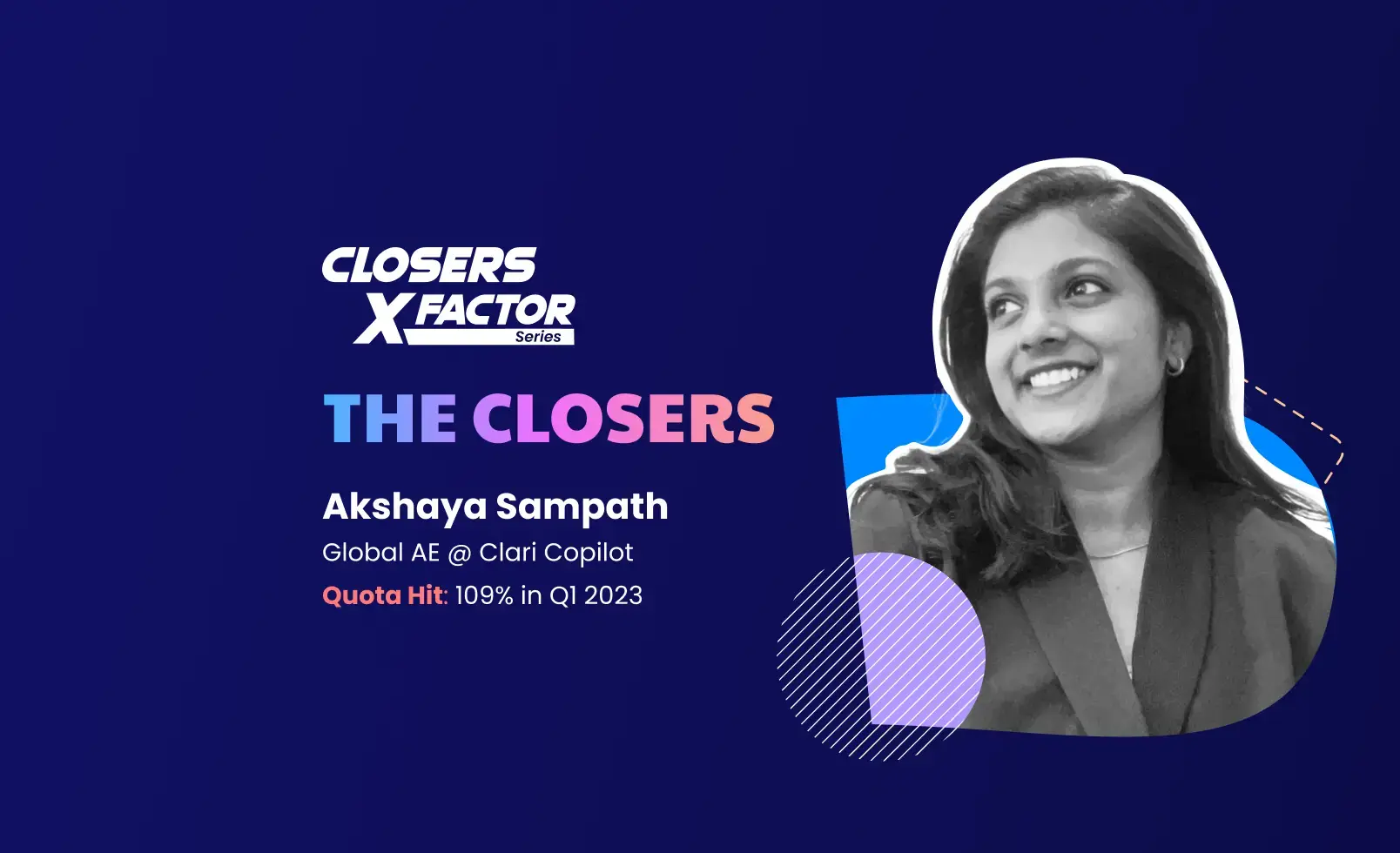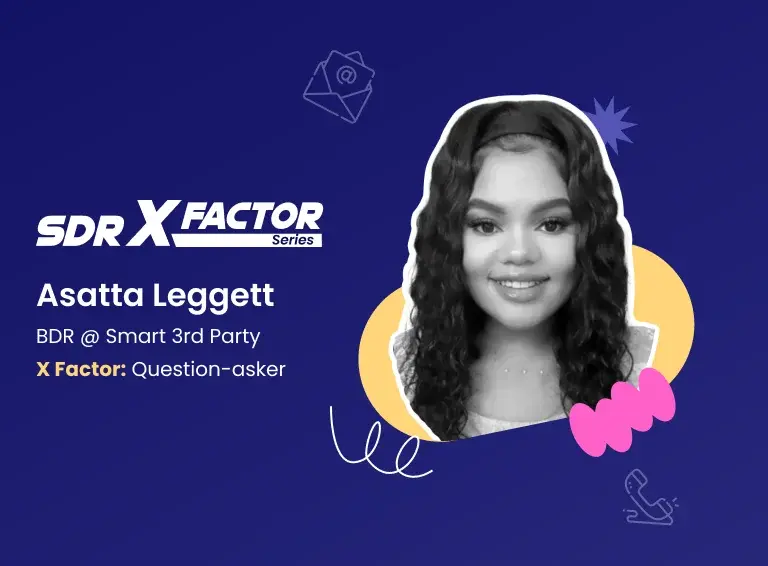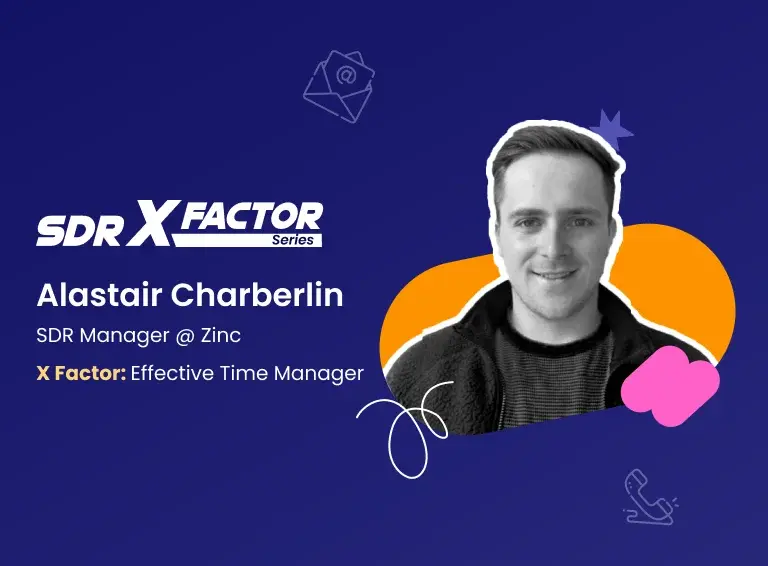Akshaya Sampath didn't seek a cushy tech job despite graduating with a computer software engineering degree. She wanted to be on the frontlines, talking to people. So, in true sales fashion, Akshaya cold messaged a sales director of a SaaS company on LinkedIn and landed her first job as an SDR.
Next, she moved to Clari Copilot (formerly Wingman by Clari), where she’s now a Global Account Executive and hit 109% of her quota for Q1 2023. Akshaya now has over 3 years of experience in B2B SaaS sales under her belt.
In this 5th episode, we unveil this brilliant AE’s no-nonsense approach to sales—from running demo calls to negotiating and everything in between—that helps her close high-ticket deals and smash quota every time.
1) Less Is More: Keep Pre-Call Research Minimal & Meaningful
Having 3 to 5 new calls scheduled every day, Akshaya doesn’t prefer over preparing before her demo calls. For both inbound and outbound leads, she keeps her research minimal but meaningful.
In general, she looks into their LinkedIn profiles to see if there’s something interesting in the About section. Next, she looks at how long they’ve been with the company to pivot her pitch accordingly.
For prospects who’ve been with the company for only a few months, she taps into their willingness to bring about a change in the company. If they’ve been with the company for a long period, she lets them talk more about why they’ve come on the call.
Specifically, if the prospect is an outbound lead, she looks to understand:
- Why did they get on a call with her?
- What did the SDR of her company note down about them?
- Why is she targeting their company?
For inbound leads, she looks into:
- Which marketing campaign generated this lead?
- How did her solution solve their pain points for customers?
- Which industry does the prospect’s company fall under?
"It's very important to understand how long the person has been with the company because the way you talk to them is going to differ from there."
2) How To Cut to the Chase During Demo Calls
If there’s one thing that Akshaya can’t stand in demo calls, it’s small talk and other fluff.
Given her demo calls are scheduled for just 30 minutes, she likes to get straight to the point. Here’s how she divides the call:
- 10 minutes for initial discovery
- 15 minutes for the demo
- 5 minutes for discussing the next steps
For the initial discovery, she asks the prospect the reason for coming on this call and the top 3 requirements they are looking for.
Before starting the demo, she confirms 3 more things about the prospect:
- Their tech stack
- The competitors they’re evaluating
- Their timeline to close the deal
During the demo, she enters these 3 requirements that they shared in the Zoom chat window and only sticks to these 3 use cases. For each of these use cases, her 3-step approach will be:
- “This is the problem statement.”
- “This is how you solve it using the solution.”
- “How do you feel about it?”
With the last open-ended question, she gauges the prospect’s interest in the solution and gets their consent to schedule another call to show the remaining features that don’t directly address these 3 use cases.
"It is not about your solution, it is about their requirements. Once you place that first, you know how to drive the conversation."
3) Key to Rapport Building: Don’t Take Yourself Too Seriously
Nobody likes an uptight rep. So, a little humor can go a long way in building rapport with prospects.
But poking fun at the prospects is risky. Imagine losing a deal over a bad joke.
So, a foolproof way to infuse humor in sales conversations and keep the prospects engaged is by not taking yourself too seriously.
Akshaya pulls this off by keeping it lighthearted with a little bit of self-mockery:
- During her initial discovery conversation, if she feels she’s asked too many questions and the prospect hasn’t spoken a lot, she’d say: “I'm so sorry. It might have felt like an interview. Now, let me just show you the product. I know I've talked enough.”
- In the demo, if her conversation intelligence platform gives her a monologue alert, she’d point to it with mock exasperation: “It's for people like me. I just speak so much that you get bored. See, now I have this thing popping up on my screen asking me to shut up!”
Her recipe for rapport building has 4 ingredients:
- Keeping the conversation informal yet professional
- Maintaining eye contact with prospects
- Smiling a lot during the call
- Avoiding jargon or complicated questions
"I’m not a tech person. And that's the most boring thing that you can do on your first call, because it's going to be like a lecture. Who has ever enjoyed a lecture? We are not geeky nerds, and that's why we are in sales!"
4) Getting Ghosted After the Demo? Here’s How to Clearly Outline the Next Steps
As a salesperson who likes to keep things straightforward, Akshaya directly asks the prospects what the next steps after the call should look like.
- If the prospect replies that they have to think about it, she’ll tell them, “Typically, this is what we do,” and explain her usual next steps.
- If they do have an idea of the next steps, like discussing with their team or leadership, she ensures to get a date and time on the calendar from them to schedule a call.
Either way, she gets a specific date and time from the prospect by the end of the call to schedule another call. This helps her to prevent getting ghosted after the demo.
If the prospect doesn’t commit to another call immediately and asks to continue the conversation in emails, she asks in a funny tone of voice: “What if I get ghosted? I'm sorry if I came on too blunt, but I am a sales rep, and I've been ghosted all my life!”
This usually gets a laugh—and a time for reconnecting—from the prospects.
"There is no, ‘You know what? I'll get back to you.’ I’m like, ‘Okay, you can get back to me, but I'm gonna put a time hold on my calendar right now.’ I lay out clear next steps."
5) Be on the Same Page With Prospects During Negotiation
Towards the end of the demo call, Akshaya briefly brings up pricing and qualifies their budget to set the tone for the negotiation stage.
She always handles negotiations over video calls and never over emails. Calls help her understand her prospect's concerns regarding pricing better, which, in turn, helps her ask the right follow-up questions.
If the prospect negotiates for a particular price, she always asks the reason for the number they’re giving. Next, she sets the expectation with the prospect about the threshold of discount she can provide.
"I need the logic behind why you think that number makes sense. If you're able to give me that logic, I'm gonna fight internally to get you that price if that logic makes sense. If that logic doesn't make sense, I walk away."
6) The One Question That Creates Urgency to Close Deals
As Akshaya works with a high-velocity motion, creating urgency in the prospect’s mind to close the deal ASAP is her priority in the negotiation process.
But, she doesn’t have any elaborate process to create urgency. All she asks the prospect is one question:
- “What happens if you don't buy the product?”
As they ponder this question, she attempts to influence the prospect by quantifying its benefits, like how much time her solution will save them and its ROI to their company. This helps in getting them to sign the deal quickly.
"You need to pluck words out of your prospect’s mouth rather than you putting it into their mouth."
7) This Tiny Gesture Goes a Long Way in Engaging Stakeholders
AEs need to deal with multiple stakeholders as they go through the sales process till the deal becomes a closed-won. How to engage all of them in your emails?
Akshaya’s simple trick:
Specifically address the queries raised by specific stakeholders in her post-demo emails to prospects. She CCs all the stakeholders in these emails.
If one of the lower-level stakeholders asked a question in one of the calls, she’d mention their name and answer their question in the email that’s addressed to a C-suite executive.
This way, she builds confidence among all the stakeholders and takes the deal close to the finish line.
"It makes them feel special, like, ‘She's addressing my concern, although the CEO was on the call.’ You give them that sense of pleasure. And the CEO also feels, ‘These people are paying attention to my team."
8) How to Close Deals During an Economic Downturn?
Fears over a recession loom large everywhere, and businesses are cutting down expenses. How are sellers like Akshaya shaping their sales pitches to reassure the cost-sensitive buyers of today?
Here are the 3 things Akshaya focuses on to sell successfully in this economic downturn:
- Keeping her pipeline healthy by disqualifying prospects who aren’t a good fit. This enables both the AE and the prospect to move on quickly, saving time for both.
- Putting the prospect first at all stages of the sales process, so that even if the prospect ends up choosing the competitor, they come back to purchase her solution.
- Setting the prospect’s expectations right during the negotiation stage to avoid back-and-forth and close the deal soon.
"Setting expectations straight on the negotiation call is what I believe in. If you've done that correctly, you will be able to save a lot of time writing to and fro follow ups."
9) On the Side
One Rule You Don’t Compromise on To Maintain Work-Life Balance?
“I never compromise on my time-offs.”
Which Sales Leaders Do You Follow?
“I’m a fan of the JBs (Josh Braun and John Barrows). Justin Welsh is someone I look up to. Also, I work with Kyle Coleman.”
What Is the Best Sales Advice You’ve Ever Received?
“Hardest times test the strongest folks.”
That’s a wrap on the fifth episode of The Closers X Factor series, where we uncover the processes that help top-performing AEs close deals every time. We'll be putting out a story of one outstanding AE every week, which you can read here. The series is written by me, Akileish R, and edited by Ashitha Jayaprakash.
Also, if you’re in the mood to learn how top sales reps can break quota records, here’s the previous season—The SDR X Factor series—featuring 8 quota-smashing SDRs from companies like G2, Metadata, Zinc, and more. See you real soon!





